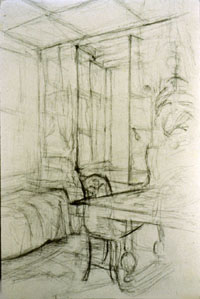
Organizational lines also relate foreground subjects to background information and so help in the arrangement of visual information in the picture plane. These lines are used to take measurement of height, width, and depth of the subject(s) and the space occupied. Like gesture lines, they are stated multiple times as the artist establishes the correct proportions in the drawing.
Using a loose grip on the drawing tool and relatively light continuous pressure, the shoulder and elbow are used in drawing the essential vertical and horizontal elements of the subject. The subject being drawn is constantly referenced as the drawing develops. No lines are erased, rather they are built upon as changes are made during the course of the drawing.
Some General Guidelines for Organizational Line Drawing.
1. Begin with vertical and horizontal lines that are both actual and implied; add diagonal lines last.
2. Establish heights and widths of all objects as well as background shapes.
3. Allow lengths of line to cross objects in order to establish a means of measurement between them.
4. Extend lines that are related to an object into the negative space.
5. Check on proportions by comparing the relative height and width of the objects and their structural elements as defined by your initial exploration of boundaries and interior information.
6. Make corrections based on analysis of your drawing and observation of the subject. Use relatively darker lines to establish which proportions are correct.
7. You can direct the viewer's eyes through the drawing by means of darker lines and more fully defined shapes. Do not erase. Do not shade in the shapes developed.

Organizational line can be understood as a means of providing a working framework for a drawing and it can be compared with how scaffolding is used in the construction of a building. Vertical and horizontal lines are initially stressed and the form is built from its foundations up.
Organizational lines are used to take measurement of the object, its parts and surroundings. These lines extend into space and like gesture and continuous line drawings, they are not confined by the edges of an object. They call upon the artist to explore the obvious boundaries of the subject as well as to uncover its subtle surface characteristics that suggest structure. Unbroken line cross from boundary line to boundary line of an object and often across lines that define one object versus another.
| Art 130A | Anna Asebedo |
| Notes on Organizational Line Drawing |